Powder coating contractor ABF Color has identified mechanical pre-treatment as the key to its success. This company was indeed one of the last coaters to be established in its area but one of the first to install a shot blasting machine from Carlo Banfi, now an OMSG brand, for the mechanical pre-treatment of large parts. In 2023, it acquired its third coating plant, retaining its trusted suppliers, including OMSG, Silvi, Gema, and Futura, and combining mechanical pre-treatment with a chemical stage for even more effective substrate preparation.
The optimal adhesion of paint layers and the effective corrosion protection of metal substrates cannot be guaranteed without adequate surface preparation. During machining, sheet metal surfaces are contaminated with either organic residues, such as lubricants used to reduce friction and/or heat, or inorganic residues, such as oxides and calamine resulting from hot machining stages or burrs and dust generated in stamping or cutting operations. For the latter, the introduction of laser cutting in manufacturing has brought many advantages over traditional mechanical systems, both from an economic point of view, because the process is faster, and in terms of results, since it allows for higher precision with a tolerance of +/- 0.1 mm, thus eliminating the need for further treatments. This type of operation does, however, result in the formation of inorganic residues such as dust and burrs, albeit in small quantities.
“Shot blasting is the ideal solution to ensure the complete removal of these limited amounts of contaminants that can, however, substantially affect the quality of the subsequent coating operation,” states Adriano Baesso, the owner of ABF Color Srl (Curtarolo, Padua, Italy) with his brother Francesco. “This is one of the last companies established in our area to powder coat large-sized fabrications. As such, in an area – the Veneto region – dotted with many contractors offering the same service as ours, we chose to differentiate ourselves by specialising in the surface preparation of steel by shot blasting and immediately equipping ourselves with the first of three plants that we would go on to have OMSG - Officine Meccaniche San Giorgio (Milan, Italy) design and install for us. This strategic choice enabled us to win the trust of our customers in just a few months, which has grown exponentially since then.”
Previous experience
The Baesso family is the heir to a long-standing company celebrating its 130th
anniversary this year. “My father runs Fratelli Baesso, which has been producing wine-making machines since 1895,” Adriano tells us, “and has an in-house coating department for the steel they are made of. ABF Color’s experience in surface coating comes from there – an incredible training ground, as the regulations governing food-contact coatings are among the strictest. Partly due to the family business’ celebrity, the establishment of ABF Color in 2013 raised a lot of curiosity but also mistrust on the part of other local companies. Such scepticism, probably motivated by the fact that my family’s name was linked to the wine industry and not to the coating one, was, however, quickly overcome. Within a few months, we had presented all the region’s leading metalworking companies with our services, promoting shot blasting as an alternative to traditional surface preparation. As mentioned, we were among the first to install a shot blasting plant for structural steelwork in our area, and this choice was the springboard for our business.”
The Veneto region’s coating cluster
“We have also gained a lot of trust from institutions. In 2019, several regional and European government representatives attended the inauguration of our new factory, built in partnership with company Peruzzo Srl, which produces machines for public green care and sports facilities. The event’s appeal enabled ABF Color to become known in a wider geographical area. At the same time, our business ethics soon led us to collaborate with other local companies offering the same services as us to create a coating cluster that today also attracts customers from other regions. We can perform special cycles with an excellent quality/price ratio, and this has also been a winning weapon.”
As a result, ABF Color’s production volumes grew well beyond expectations. At the end of 2023, it inaugurated a new factory with a third coating plant, which is now fully operational. “We dismantled our first plant, installed in 2013,” indicates Adriano Baesso, “and we currently manage our volumes using the other two lines: the 2019 one handles large-sized, heavy-duty components, whereas the newest one coats lighter and smaller parts, such as the ones intended for the agricultural sector.”
The coating plant for heavy-duty components
The coating line built in 2019 has a step-by-step monorail conveyor built by Silvi (Lesmo, Monza e Brianza, Italy), which also acted as the prime contractor and took care of the design and installation of the curing oven. The plant can treat components up to 11 m in length, 3 m in height, 1.6 m in width, and over 5 tonnes in weight. “This is the only line in the region with these characteristics,” says Baesso. “Silvi’s technical team developed for us a unique structure to handle very heavy components. It collaborated with OMSG – which had already supplied us with our first shot blaster in 2013 and, for this project, provided a shot blasting machine from Carlo Banfi, the brand it acquired in 2017 – and Gema – which designed and installed a custom booth equipped with 12 guns (6+6) and Venturi injectors to powder coat the peculiar components we are required to treat. All of these three companies have been our trusted suppliers since 2013. Futura Convogliatori Aerei became one of them more recently after supplying us with the conveyor for the latest coating line.”
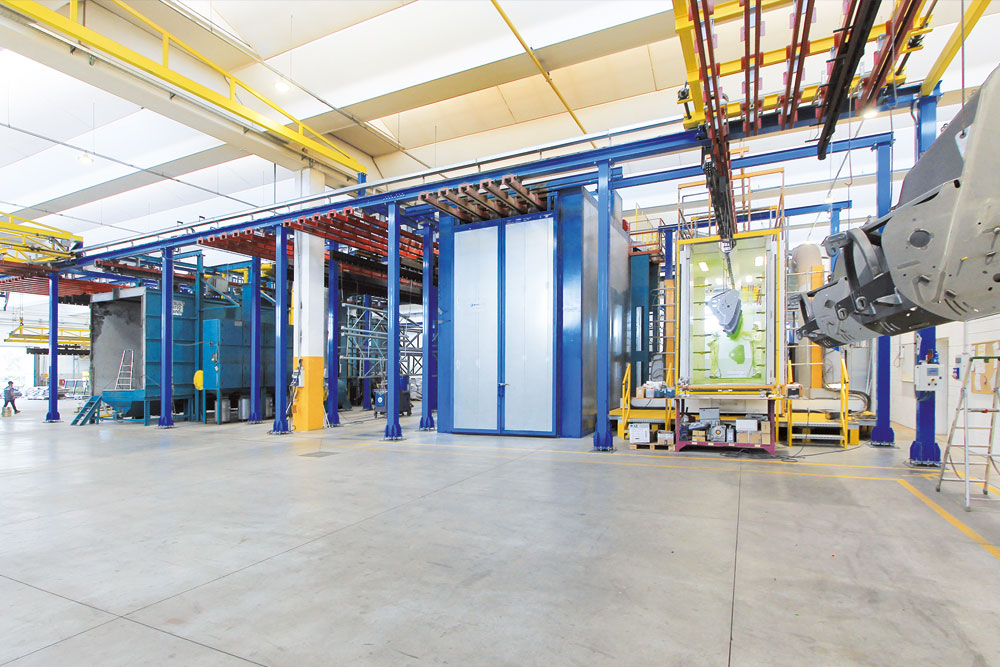 Overview of the line installed in 2019, with a shot blasting machine, an oven, and a powder coating booth. © ipcm
Overview of the line installed in 2019, with a shot blasting machine, an oven, and a powder coating booth. © ipcm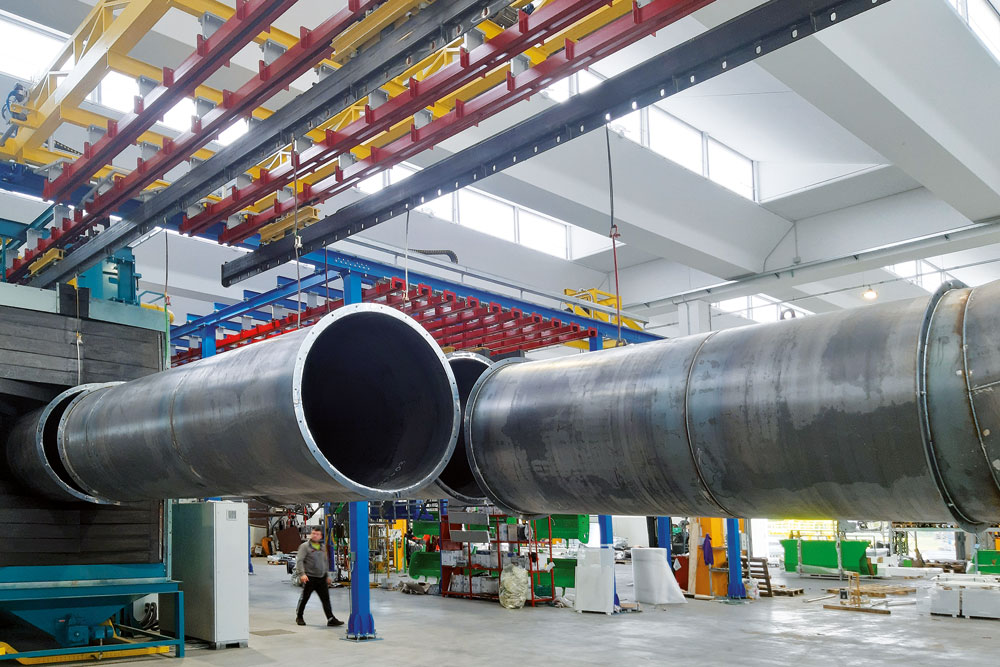 The plant installed in 2019 can treat components up to 11 m in length and over 5 tonnes in weight. © ABF Color
The plant installed in 2019 can treat components up to 11 m in length and over 5 tonnes in weight. © ABF Color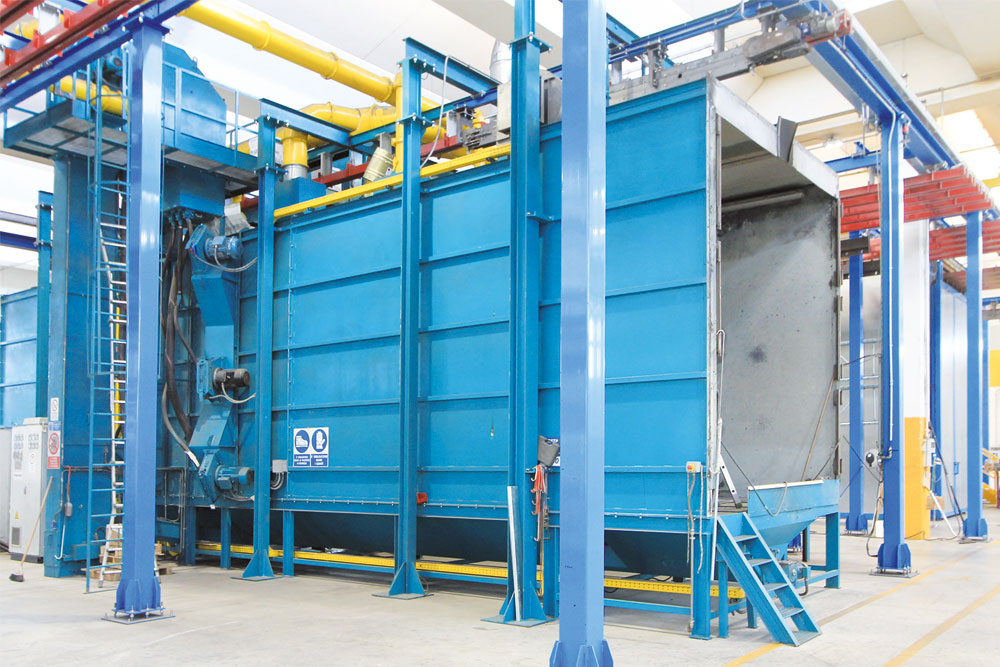 The exterior of the Carlo Banfi shot blasting machine, using spherical steel abrasive. © ipcm
The exterior of the Carlo Banfi shot blasting machine, using spherical steel abrasive. © ipcm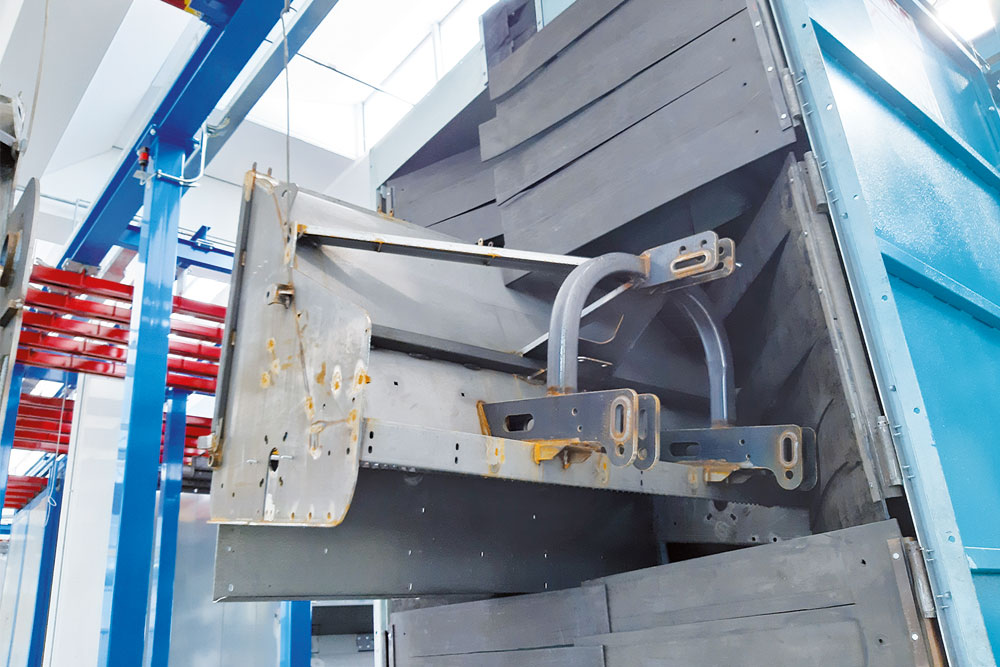 A heavy-duty component entering the shot blasting system. © ABF Color
A heavy-duty component entering the shot blasting system. © ABF ColorThe parts coated here are predominantly beams, metal mezzanines, and large structural metalwork, which undergo mechanical pre-treatment, with spherical steel abrasive designed in partnership with supplier Winoa to achieve the SA 2½ cleanliness grade and the roughness profiles required by customers, and the application of one- to three-layer coating systems for iron and stainless steel, up to corrosion class C5 for hot-dip galvanised steel. “Our next milestone will be obtaining ISO 12944 certification, confirming the corrosion protection effectiveness of our coatings.”
Involvement in major projects
One of the projects of which ABF Color is most proud is the one realised for the Lakhta Center in Saint Petersburg (Russia), which houses the offices of Gazprom. “We coated the structural metalwork of 30 of the 90 floors of this building facing the Baltic Sea and, therefore, subjected to a high degree of salinity, successfully exceeding all specified quality standards. Lately, we have also been making a name for ourselves in the naval sector, thanks to a customer that manufactures components for the British navy: after an initial request to coat material for three ships, we have received an order for six ships, confirming that our coating results are excellent and guarantee perfect resistance to the saline environment. We also coat furnishings for cruise ships: the tests conducted on them also proved their excellent degree of corrosion resistance after one year of daily exposure to the marine environment.”
The coating plant for light-duty components
“The decision to build a new line arose from the need to relieve the larger plant of batches with smaller parts – mainly intended for the agricultural sector, whose major brands, such as Kubota, have certified our coating cycle – and speed up our production flow,” explains Baesso.
“Unlike the other plant, where we only perform mechanical pre-treatment, this line can perform a chemical, mechanical, or combined chemical + mechanical pre-treatment operation to prepare the surfaces adequately depending on the type of finish required by the customer.”
This new line, therefore, consists of a continuous-flow, boxed, monorail conveyor from Futura (the largest in the range of this type of overhead conveyor) with 3 m load bars with a capacity of 500 kg each and a speed of 1 m/minute; a Tunnelblast shot blasting machine supplied by OMSG; a four-stage chemical pre-treatment tunnel; an oven divided into two zones, one for drying after chemical pre-treatment and one for powder curing at 180 °C; and a Magic Cylinder EquiFlow booth from Gema, also equipped with 12 guns and two stations for post-finishing to reduce the scrap rate.
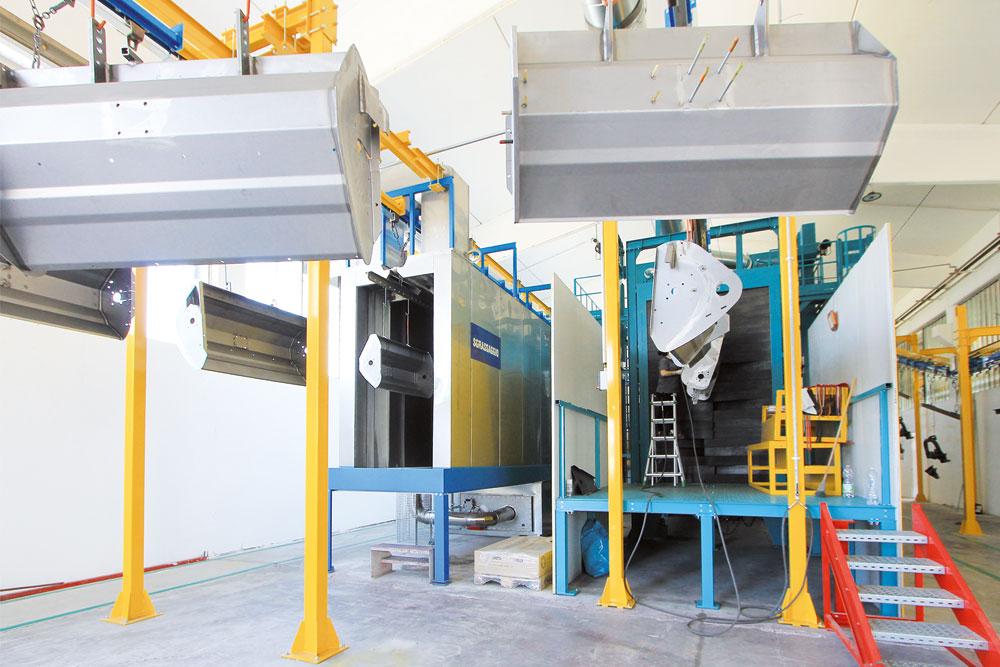 The two units performing chemical (left) and mechanical (right) pre-treatment on light-duty metal components. © ipcm
The two units performing chemical (left) and mechanical (right) pre-treatment on light-duty metal components. © ipcmCharacteristics of the Tunnelblast machine
“The Tunnelblast 1525/12 series system,” illustrates Enzo Dell’Orto, the CEO of OMSG, “is the third shot blasting machine installed by OMSG at ABF Color. It is a tunnel-type plant suitable for treating medium and large-sized components moved horizontally, combined with an overhead conveyor (monorail or power&free type). The maximum workpiece dimensions are 1.5 m in width and 2.5 m in height. The shot blasting operation is carried out through 12 7.5-kW, single-disc turbines equipped with a direct drive motor, which project the metal abrasive at about 80 m/s over each workpiece’s entire surface as it moves through the tunnel. 12 inverters control the rotational speed of the turbines and the resulting kinetic energy of the abrasive, preventing the deformation of thin sheets. The plant is also equipped with 12 special valves to feed the turbines, with two pneumatic cylinders. One of the main features of this shot blasting machine is that the rubber bands acting as screens to prevent the abrasive from escaping can be opened automatically by a device operated by pneumatic cylinders, to enable the workpieces that do not need to be subjected to shot blasting to pass through quickly. Finally, the machine is managed by a Siemens S7-1200 PLC with a 12” touch panel, already prepared to comply with the Industry 4.0 parameters and be integrated with the company’s management system, which is currently in the ramp-up phase.”
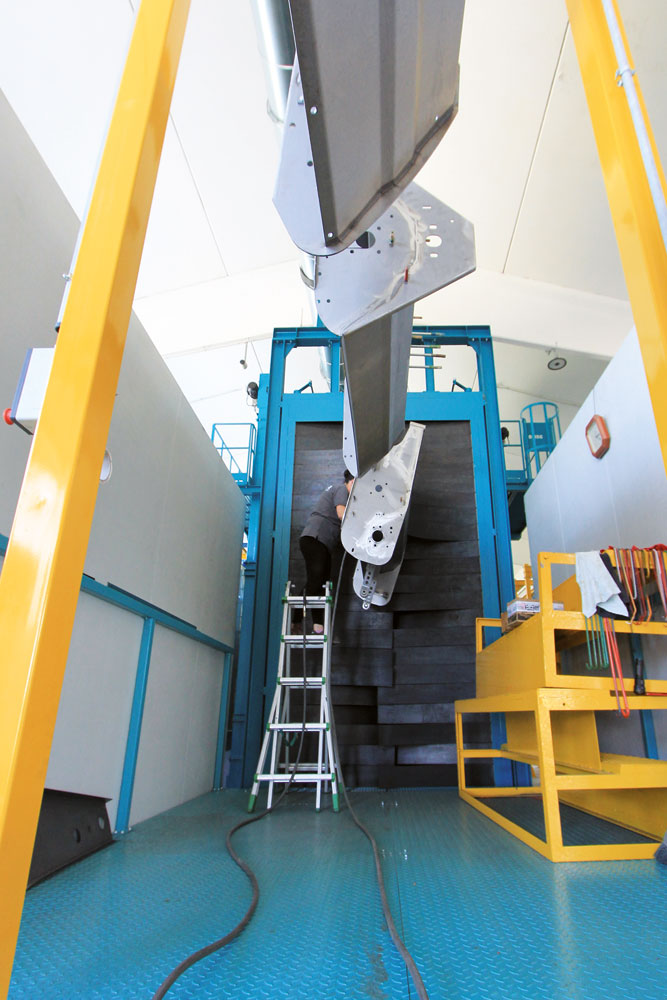 Components exiting the Tunnelblast shot blasting system. © ipcm
Components exiting the Tunnelblast shot blasting system. © ipcm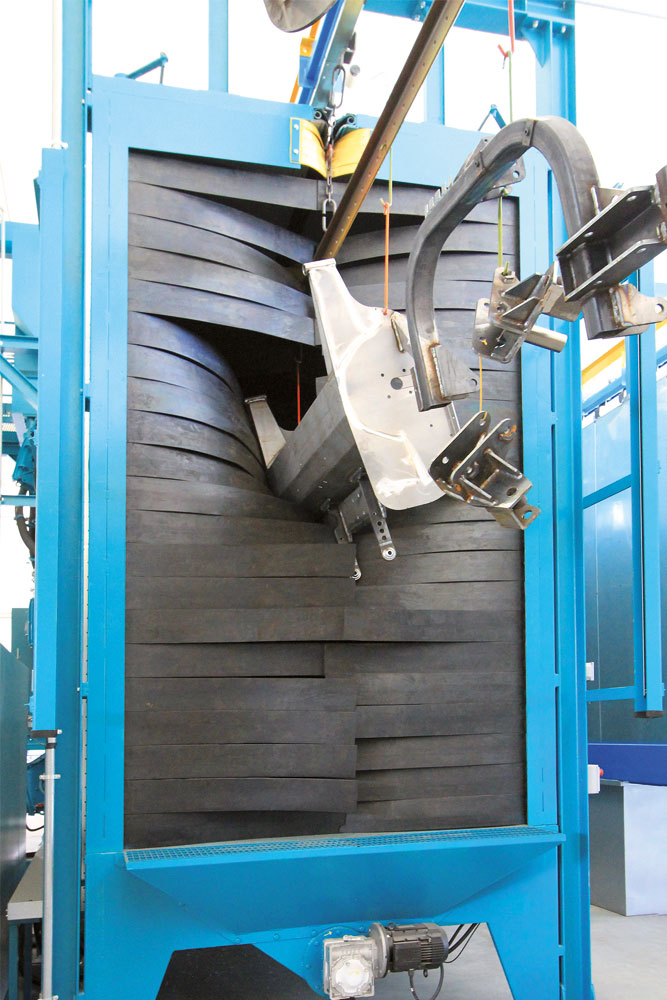 The rubber bands can be opened automatically through a device operated by pneumatic cylinders so that the workpieces that do not require a shot blasting treatment can pass through quickly. © ipcm
The rubber bands can be opened automatically through a device operated by pneumatic cylinders so that the workpieces that do not require a shot blasting treatment can pass through quickly. © ipcmThe pre-treatment tunnel and the drying and curing oven
The pre-treatment tunnel consists of four stages: 180-second degreasing, two rinses of the same duration (60+60 seconds, one with mains water and one with demineralised water), and a nanotechnology no-rinse passivation stage.
“Identifying the right size for each zone was crucial to avoid any product overflow or dragging that would pollute the adjacent stages,” emphasises Silvi CEO Daniele Fumagalli. “The system we supplied to ABF Color is 28.3 m long, 1.6 m wide, and 4.68 m high, and the workpiece maximum dimension is 1.2 x 2.5 m. Both the upper part, which houses the actual tunnel where the spray bars are placed, and the lower part, where the tanks are located, are made of AISI 304 stainless steel. The tanks are also insulated with rock wool with a thickness of 60 mm. The tunnel has three doors for inspection and an access ladder. The demineralisation plant can treat 3,000 litres of water per hour.”
Silvi also designed and installed the drying and curing oven: “The drying oven, which operates at a maximum temperature of 180 °C, consists of a robust supporting structure made of electro-welded galvanised steel profiles and an insulating layer of highly insulating rock wool. Our technical department has developed a special type of high-efficiency, backward electric fan to circulate the heating air. A plenum space is placed over the entire base of the oven for even distribution of hot air. Suction is regulated with adjustable shutters located on the underside of the oven. A fan specially positioned on the roof ensures the discharge of the products resulting from the curing of powders. At the same time, this air mass is compensated with filtered air intake. Finally, the curing oven has two combustion chambers totalling 300,000 kcal/hour and can reach a maximum temperature of 240 °C. ABF Color uses it under special operating conditions.”
A peculiar operational choice
“Our two- or three-coat cycles,” Baesso confirms, “include a dry-on-dry application process with two or three dwells in the curing oven for 50 minutes. We decided on such a long curing phase because we noticed that the paint layer can flake off more quickly if it lasts less. Originally, the oven temperature was up to 180 °C, but the temperature of the parts leaving it did not exceed 120 °C. However, we need them to reach 180 °C as well. Therefore, we have them dwell longer than standard in the curing oven, with excellent results for both high sheet thicknesses (55 mm) and reduced thicknesses (35 mm).”
Long-standing, winning partnerships
As Adriano Baesso emphasised several times in our interview, ABF Color has always been supported in its growth path by the same suppliers. “Since our establishment, we have strived to select the best technologies on the market. In the case of OMSG, we started collaborating as early as 2013, and we immediately established an excellent personal relationship with its owner, Enzo Dell’Orto, which went well beyond the professional partnership. The reliability of this company is undisputed, as is the efficiency of its service: it has always solved any issue faced by ABF Color in a very short time. Silvi, represented by its owner Daniele Fumagalli, acted as the prime contractor for the two most recent installation projects: I chose it because it presented us with solutions that I had not considered at all and whose effectiveness I was able to assess by visiting several plants installed by this Monza-based company. As for Gema, in addition to providing the best application equipment in terms of performance and speed, it offers truly innovative solutions. One of its latest innovations I would like to implement in our new plant is the Dynamic Contour Detection system, whose laser scanners ensure greater coating precision, increased transfer efficiency and finishing quality, and faster production flow with reduced touch-up frequency. Once I will verify its degree of performance, I may consider installing it on the older line as well.
“I would like to conclude by emphasising that we would not have grown up to this point without the collaboration of all these partners: their know-how and expertise have always compensated for the investment made in their equipment,” says Baesso. And ABF Color’s growth will not stop here: the company has already acquired another one-hectare plot of land on which it plans to build a new coating plant.